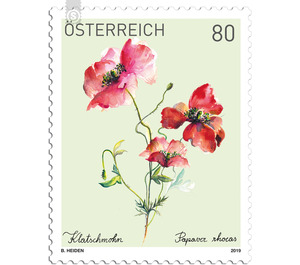Loyalty bonus stamp 2018 - Austria / II. Republic of Austria 2019 - 80 Euro Cent
Theme: Flora
| Country | Austria / II. Republic of Austria |
| Issue Date | 2019 |
| Face Value | 80.00 |
| Color | green red |
| Printing Type | offset |
| Stamp Type | Commemorative |
| Item Type | Stamp |
| SID | 280133 |
| Dimensions | 33.00 x 42.00 |
| In 110 Wishlists | |
It is the brilliant red flower of the poppy that is depicted on this year’s loyalty bonus stamp, with which Austrian Post thanks its subscribers for their loyalty. The common poppy (Papaver rhoeas), which originated in the Mediterranean region has spread throughout the arable landscape worldwide. At one time the plant with its striking petals was to be seen in every field and every meadow. However, thanks to the use of herbicides and the careful removal from seeds of any contamination, it, like many other wild flowers, has seen a continual reduction in its habitat. Nowadays poppy flowers are mostly found on wasteland, embankments and along the wayside. This undemanding plant with pinnate leaves flowers from May to July. The blooms are usually red, but sometimes also white or purple, and the petals have a black mark on the inside. Once the blooms are spent, large capsules containing thousands of tiny seeds – poppy seeds – are formed, which are then spread by the wind. Use and symbolism The poppy seed that we use in our kitchens for poppy seed strudel and other delicacies actually comes from another variety of poppy, the opium poppy (Papaver somniferum), the dried latex of which is used to make opium and morphine. The common poppy also contains alkaloids such as rhoeadine, which is why all parts of the plant are mildly toxic. In the past the common poppy was used to make a cough syrup, but there is no evidence that it was effective. Dried red petals are often added to tea blends as a so-called brightening agent. The young leaves can also be used in small quantities in salads or as a vegetable. Nowadays the common poppy is available in a range of colours as an ornamental plant. In the English-speaking world, red poppy petals are used as a symbol of remembrance for victims of the wars. This tradition can be traced back to the poem “In Flanders Fields”, in which, in 1915, a Canadian soldier writes about the poppies on the graves of his fallen comrades. The red poppies are a reminder of the blood shed, but also of the painkiller morphine, obtained from the poppies, which was often used in the field hospitals.


